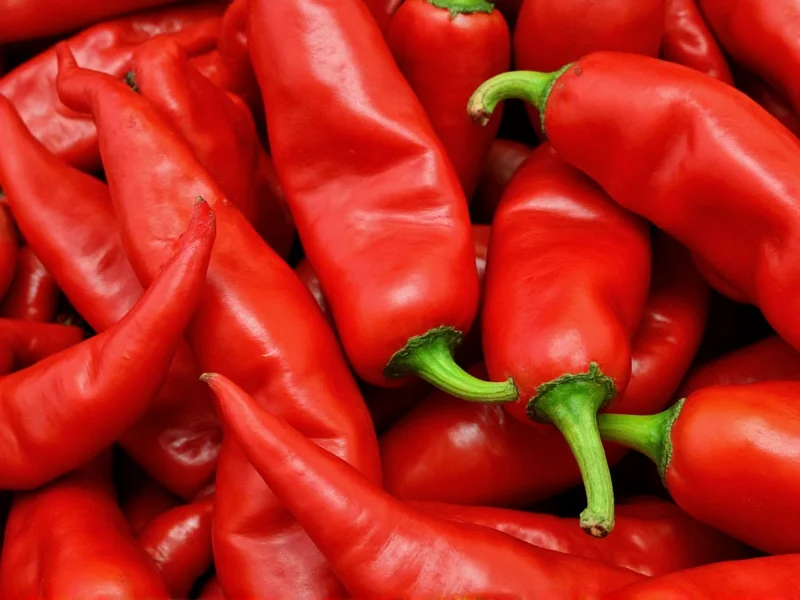Understanding Poblano Pepper Heat Levels
Poblano peppers deliver a gentle warmth rather than intense heat, placing them firmly in the mild-to-medium category of the chili pepper family. These dark green, heart-shaped peppers originated in Puebla, Mexico, and have become popular worldwide for their balanced flavor profile that combines earthy notes with manageable spiciness.
The Scoville scale provides the definitive measurement for chili pepper heat. Developed by pharmacist Wilbur Scoville in 1912, this scale quantifies capsaicin concentration—the compound responsible for spiciness in chili peppers. Poblanos consistently register between 1,000-2,000 SHU, though specific growing conditions can cause minor variations in heat intensity.
Pepper Heat Comparison Chart
| Pepper Type | Scoville Heat Units (SHU) | Heat Level |
|---|---|---|
| Bell Pepper | 0 SHU | No heat |
| Poblano Pepper | 1,000-2,000 SHU | Mild to medium |
| Jalapeño Pepper | 2,500-8,000 SHU | Moderate |
| Serrano Pepper | 10,000-23,000 SHU | Hot |
| Habanero Pepper | 100,000-350,000 SHU | Very hot |
Factors That Influence Poblano Pepper Heat
Several elements affect how hot your pablano peppers might be:
Ripeness Stage
Green poblanos (harvested early) tend to be milder, while red poblanos (fully mature) develop slightly more heat along with sweeter, fruitier notes. The red variety, sometimes called ancho peppers when dried, maintains the same moderate heat range but offers more complex flavor.
Growing Conditions
Environmental stressors significantly impact heat levels. Poblanos grown in hotter, drier conditions with less water typically develop higher capsaicin concentrations. This explains why some pablano peppers are hotter than others even within the same batch.
Seed and Membrane Content
The white pithy membranes and seeds contain most of the capsaicin. When preparing poblanos, removing these parts substantially reduces heat—useful knowledge for those wondering how to reduce heat in pablano peppers while preserving flavor.
Culinary Applications of Poblano Peppers
Chefs value poblanos for their versatility. Their moderate heat allows them to enhance dishes without dominating other flavors. Common uses include:
- Chiles Rellenos—stuffed poblano peppers, often with cheese
- Rajas con Crema—sliced roasted poblanos in cream sauce
- Mole sauces—where dried poblanos (anchos) contribute depth
- Guacamole and salsas—adding subtle warmth without overpowering
When roasting pablano peppers, their skin blackens and blisters, which many find enhances their natural sweetness while slightly mellowing the heat—answering whether roasted pablano peppers are less spicy (they are, marginally).
Poblano vs Jalapeño: Understanding the Heat Difference
Many home cooks wonder how hot are pablano peppers compared to jalapeños. The difference is significant: jalapeños typically range from 2,500-8,000 SHU—up to four times hotter than poblanos. This makes poblanos an excellent choice for those who want chili flavor without intense heat, particularly in dishes served to children or spice-sensitive individuals.
When substituting between these peppers, remember that using a jalapeño in place of poblano will dramatically increase heat levels. Conversely, replacing jalapeños with poblanos creates a much milder dish.
Handling Poblano Peppers Safely
While poblanos are relatively mild, proper handling prevents accidental irritation:
- Wear gloves when handling large quantities
- Avoid touching your face, especially eyes
- Wash hands thoroughly with soap after preparation
- Use separate cutting boards for peppers
Despite their moderate heat rating, capsaicin transfers easily to skin and mucous membranes. These precautions address common concerns about why are some pablano peppers hotter than others—your sensitivity matters as much as the pepper's actual heat level.
FAQ: Common Questions About Poblano Pepper Heat
How hot are poblano peppers on the Scoville scale?
Poblano peppers measure between 1,000 to 2,000 Scoville Heat Units (SHU), placing them in the mild-to-medium category of chili peppers. For reference, this is about half as hot as the average jalapeño pepper.
Are poblano peppers hotter than jalapeños?
No, poblano peppers are significantly milder than jalapeños. While poblanos range from 1,000-2,000 SHU, jalapeños typically measure 2,500-8,000 SHU—making them up to four times hotter than poblanos.
Do roasted poblano peppers lose heat?
Roasting slightly reduces poblano heat by breaking down some capsaicin compounds, but the difference is minimal. The primary effect of roasting is enhanced sweetness and smoky flavor, which can make the heat seem less pronounced.
Why are some poblano peppers hotter than others?
Natural variation occurs due to growing conditions—peppers exposed to more heat and drought stress produce higher capsaicin levels. Individual pepper maturity and genetics also contribute to heat differences within the same plant.
Can I reduce the heat of poblano peppers?
Yes, removing the white membranes and seeds significantly reduces heat since these parts contain most capsaicin. Soaking sliced peppers in salt water for 30 minutes can also draw out some heat compounds while preserving flavor.











 浙公网安备
33010002000092号
浙公网安备
33010002000092号 浙B2-20120091-4
浙B2-20120091-4